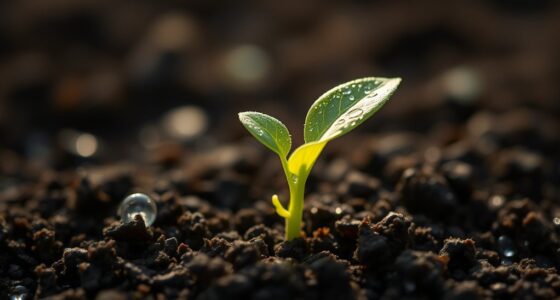Gauging the advancement of spiritual development may appear to be an insurmountable challenge, yet it’s a subject deserving of discussion. It’s often contended that spirituality is an intensely individual and subjective realm, which complicates any efforts to measure or assess it. Nonetheless, through the analysis of various factors and signs of spiritual progression, we are able to achieve a better understanding of the path and its results.
In this article, we will delve into the various aspects of measuring spiritual growth, including the timeframe, deepening connection, overcoming obstacles, and the importance of a supportive community. Join me as we explore this fascinating and often misunderstood aspect of personal development.
Key Takeaways
- Spiritual growth is an ongoing process that requires continuous effort and patience.
- There is no objective measurement or traditional quantification of spirituality.
- Indicators of spiritual growth include an increase in love, compassion, and forgiveness, as well as personal reflection and self-awareness.
- Developing a deeper connection to spirituality can be achieved through mindful living, seeking feedback from trusted mentors, and tracking changes.
What is it?
I can measure the progress of my spiritual growth by focusing on indicators such as an increase in love, compassion, and forgiveness, personal reflection and self-awareness, and the practice of meditation, prayer, and mindfulness.
Measuring the progress of spiritual growth involves understanding spiritual development and recognizing the changes that occur within oneself. It is a deeply personal journey that requires self-reflection and introspection.
By observing the level of love, compassion, and forgiveness in my interactions with others, I can gauge the growth of my spiritual well-being. Additionally, engaging in personal reflection and self-awareness exercises allows me to understand myself better and identify areas for improvement.
The consistent practice of meditation, prayer, and mindfulness helps to cultivate a deeper connection with my spirituality and serves as a measure of my progress.
Overall, measuring the progress of spiritual growth involves being attuned to internal changes and actively engaging in practices that enhance spiritual well-being.
Factors and Indicators
Factors and indicators of deepening connection to spirituality include developing a sense of inner peace, increased self-awareness, and a greater sense of purpose and meaning in life.
Evaluation and assessment of spiritual growth can be subjective and personal, as spirituality is a unique experience for each individual. However, there are certain factors that can indicate progress in one’s spiritual journey.
These factors can include an increased ability to forgive and show compassion, a deeper connection to a higher power or the universe, and a heightened sense of gratitude and joy. Additionally, self-reflection and mindfulness practices can contribute to a greater understanding of one’s spiritual growth.
It is important to remember that spiritual growth is an ongoing process that requires continuous effort and dedication. By paying attention to these factors and indicators, individuals can assess and measure their progress in their spiritual journey.
Measuring Spiritual Growth
To assess the development of my spirituality, I can explore various aspects of my inner self and track changes in my sense of inner peace, self-awareness, and purpose and meaning in life.
Measuring spiritual growth is a deeply personal and subjective experience, as it involves evaluating one’s own personal development and progress in their spiritual journey. It cannot be quantified or measured in traditional ways, but rather requires self-reflection, introspection, and an understanding of one’s own values and beliefs.
By paying attention to the changes in our emotions, thoughts, and behaviors, we can gain insights into our spiritual growth. Evaluating personal development involves looking at indicators such as increased love, compassion, forgiveness, gratitude, and joy, as well as a deepening connection to our inner self and a sense of alignment with our values and purpose.
Ultimately, measuring spiritual growth is about cultivating a greater sense of well-being, meaning, and fulfillment in life.
Timeframe
Developing a deeper connection to spirituality requires patience, as noticeable changes may take months or even years to occur. Measuring spiritual growth is a complex task, as it involves tracking progress in a subjective and personal journey.
The importance of measuring spiritual growth lies in gaining insight into one’s progress and identifying areas for improvement. However, there are challenges in quantifying spirituality, as it is a deeply personal and unique experience for each individual.
While there are no traditional metrics or objective measurements for spiritual growth, there are methods and tools that can be utilized. These include personal reflection and self-awareness, feedback from trusted mentors or advisors, and the practice of meditation, prayer, and mindfulness.
By incorporating these tools and practices into our spiritual journey, we can gain a deeper understanding of our progress and continue to nurture our spiritual growth.
Deepening Connection
In deepening my connection to spirituality, I have found that it requires patience and a willingness to become more attuned to my inner self. Seeking guidance from mentors or advisors has been instrumental in this process. They have provided valuable insights and perspectives that have helped me navigate my spiritual journey.
Additionally, practicing mindful living has allowed me to be more present and aware of the subtle changes and shifts within myself. It has enabled me to develop a greater sense of self-reflection and self-awareness. By being fully present in each moment and embracing mindfulness, I have been able to deepen my connection to spirituality.
Overall, it is through seeking guidance and embracing mindful living that I have been able to progress in my spiritual growth and deepen my connection to spirituality.
Overcoming Obstacles
Overcoming obstacles in my spiritual journey has required dedication, effort, and a commitment to continuous growth. Seeking guidance from mentors or advisors has been instrumental in navigating these challenges. They have provided valuable insights and perspectives, helping me to see beyond my limitations and overcome any roadblocks that I have encountered.
Embracing change has also been crucial in my spiritual growth. It has meant being open to new ideas, beliefs, and practices, and being willing to let go of old patterns and attachments that no longer serve me. Change has allowed me to expand my understanding and deepen my connection to spirituality.
By embracing change and seeking guidance, I have been able to overcome obstacles and continue to grow on my spiritual path.
Supportive Community
Now that we have explored the importance of overcoming obstacles in spiritual growth, let’s delve into the role of a supportive community in this journey.
Building relationships with like-minded individuals is crucial for nurturing spiritual growth. When we surround ourselves with people who share similar experiences and beliefs, we create a space where we can freely express ourselves and learn from one another.
Sharing experiences is a powerful way to deepen our understanding and gain new perspectives. In a supportive community, we can openly discuss our spiritual journeys, the challenges we face, and the lessons we have learned. This exchange of knowledge and wisdom allows us to expand our horizons and grow on a deeper level.
In summary, a supportive community provides the foundation for spiritual growth by fostering connections and enabling the sharing of experiences. It is through these relationships that we can find support, guidance, and the inspiration to continue on our path of spiritual development.
Continuous Growth
To continuously grow in my spirituality, I embrace change and seek guidance.
I understand that spiritual growth is not a one-time achievement but a continuous process of improvement. It is a lifelong journey that requires dedication and effort.
I believe that embracing change is essential in this journey as it allows me to expand my understanding and experience new perspectives.
Seeking guidance from mentors or advisors helps me gain insight and learn from their wisdom.
I also prioritize nurturing my connection to the divine through practices like meditation, prayer, and self-reflection.
By actively engaging in these practices and remaining open to growth and transformation, I can continue to deepen my spirituality and experience profound personal growth.
Frequently Asked Questions
Can spiritual growth be measured objectively?
No, spiritual growth cannot be measured objectively. It is a subjective experience unique to each person. While there are indicators of spiritual growth, such as increased love and compassion, it is not possible to quantify spirituality.
How long does it take to see noticeable changes in spiritual growth?
To see noticeable changes in spiritual growth, it can take months or even years. It is an ongoing process that requires patience, effort, and persistence. Progress may be slow and inconsistent, but anyone can experience spiritual growth.
Is spirituality always related to religion?
Spirituality is not always related to religion. It can exist independently, as spirituality without belief, emphasizing personal connection to something greater than oneself. Spirituality encompasses a broader, more individualistic understanding of the human experience.
What are some common obstacles in the process of spiritual growth?
Overcoming obstacles in the process of spiritual growth involves developing spiritual practices. It requires building a supportive community, seeking guidance, practicing self-reflection, embracing mindfulness, and nurturing continuous growth through love, compassion, and forgiveness.
How can one cultivate a supportive community for spiritual growth?
To cultivate a supportive community for spiritual growth, I focus on creating connections and nurturing relationships. This involves building relationships with like-minded individuals, participating in faith-based activities, and creating small groups or mentorship programs.
Conclusion
In conclusion, measuring the progress of spiritual growth is like embarking on a magnificent, never-ending adventure. It’s a journey where we dive deep into the depths of our souls, uncovering hidden treasures and unlocking the limitless potential within us.
It’s a path that requires unwavering commitment and dedication, as we navigate through the ebbs and flows of life. With each step forward, we become more connected to our spirituality, radiating love and compassion to the world around us.
It’s a transformative process that transcends time, allowing us to soar to unimaginable heights. So, embrace this wondrous expedition, for the rewards are beyond measure.









